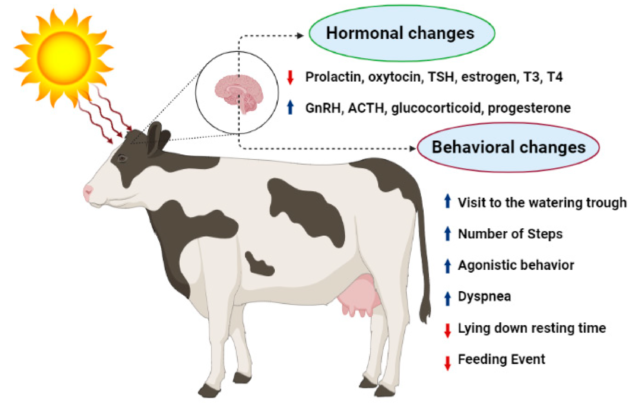Dairy animals play a significant role in India’s GDP (Gross Domestic Product). India has one of the largest cattle populations in the world, with estimates ranging from 300 to 350 million cattle. India stands first in the world in buffalo population with 112.33 million heads which is 56.37 % of the world’s buffalo population. The buffalo contribute49ers jersey Air Max VaporMax fermelamarquise.com cheapdesignerhandbagsforyou.com gorlitca.com binkleytruck.com ashevillewireless.org שטיח פרסי תל אביב Air Max VaporMax Air Max VaporMax cheapdesignerhandbagsforyou.com potlac na tricka Air Max VaporMax fermelamarquise.com exploradesign.com exploradesign.com
Effect of heat stress in dairy animals
Heat stress in dairy animals can have significant negative effects on their health, well-being, and productivity. Hence causing great loss to the dairy sector and country’s GDP as well as the farmer.
Effects of Heat stress on animal are:
1. Reduced Milk Production: Heat stress can lead to decreased milk production in dairy animals. High temperatures can cause them to eat less, reducing their overall energy intake, which directly impacts milk production. Additionally, heat stress can disrupt hormonal balance, affecting lactation.
2. Decreased Reproductive Performance: Heat stress can impair reproductive functions in dairy animals. It can lead to decreased estrus expression, irregular estrous cycles, and lower conception rates. This ultimately results in longer calving intervals and reduced herd fertility.
3. Increased Mortality Rates: Severe heat stress can lead to increased mortality rates among dairy animals. Heatstroke and dehydration are significant risks during extreme heat events, especially for animals with limited access to shade and water.
4. Impaired Immune Function: Heat stress compromises the immune system of dairy animals, making them more susceptible to diseases and infections. This can result in higher incidences of mastitis, metritis, and other health issues, leading to decreased overall herd health and increased veterinary costs.
5. Nutritional Imbalances: Heat-stressed animals may alter their feeding behavior, consuming less feed or changing their diet preferences. This can lead to nutritional imbalances, affecting their overall health and productivity. For example, they may consume fewer nutrients essential for milk production, reproduction, and maintaining body condition.
6. Heat-induced Respiratory and Cardiovascular Stress: High temperatures can cause respiratory and cardiovascular stress in dairy animals. Panting is a common response to heat stress, which can lead to respiratory alkalosis and dehydration. Additionally, increased heart rate and blood pressure put additional strain on the cardiovascular system.
7. Behavioural Changes: Heat-stressed dairy animals may exhibit altered behaviour, such as increased restlessness, reduced activity, and seeking shade or water more frequently. These behavioural changes can affect their overall welfare and may lead to management challenges for dairy farmers.
8. Economic Losses: Collectively, the effects of heat stress on dairy animals result in significant economic losses for dairy farmers. Reduced milk production, impaired reproductive performance, increased veterinary costs, and higher mortality rates all contribute to decreased profitability and sustainability of dairy operations.
Overall, heat stress is a multifaceted issue with serious implications for the health, welfare, and productivity of dairy animals, as well as the economic viability of dairy farming enterprises. Implementing strategies to mitigate heat stress, such as providing shade, adequate ventilation, and access to cool water, is essential for maintaining optimal animal welfare and farm profitability in hot climates
To mitigate heat stress in dairy animals, farmers can implement various techniques and management practices. Here are some effective strategies:
1. Provide Adequate Shade: Ensure that dairy animals have access to shaded areas throughout the day, especially during peak sunlight hours. Shade structures like trees, shade sails, or built shelters can help reduce direct exposure to the sun and lower ambient temperatures.
2. Optimize Ventilation: Improve airflow within barns or housing facilities to enhance cooling. This can be achieved through natural ventilation (windows, vents) or mechanical ventilation systems (fans, evaporative cooling pads). Proper ventilation helps dissipate heat and humidity, promoting thermal comfort for the animals.
3. Cooling Systems: Install cooling systems such as misters or sprinklers to cool the air and provide evaporative cooling for dairy animals. These systems can be utilized in holding areas, milking parlors, or loafing areas to help animals regulate their body temperature.
4. Access to Fresh Water: Ensure dairy animals have continuous access to clean and cool water. Install water troughs or automatic waterers in multiple locations within the housing area to encourage adequate hydration, especially during hot weather conditions.
5. Dietary Management: Adjust feeding practices to accommodate heat stress conditions. Provide high-quality forage and balanced diets rich in energy and nutrients to support maintenance and production requirements. Consider feeding during cooler times of the day to encourage intake and minimize heat production from digestion.
6. Reduce Stocking Density: Avoid overcrowding in housing facilities to prevent heat buildup and improve air circulation around animals. Adequate space allows for better heat dissipation and reduces competition for resources like shade and water.
7. Timely Herd Management: Schedule routine tasks such as feeding, milking, and handling during cooler parts of the day to minimize heat stress on dairy animals. Additionally, monitor herd health closely and promptly address any signs of heat stress or related health issues.
8. Heat Stress Monitoring: Implement monitoring systems to track environmental parameters such as temperature, humidity, and heat index. This data can help farmers anticipate and respond to heat stress conditions effectively, implementing interventions as needed to protect animal welfare.
9. Genetic Selection: Consider selecting dairy breeds or genetic lines known for heat tolerance and adaptability to hot climates. Breeding for heat-resistant traits can help improve the overall resilience of the herd to heat stress conditions.
10. Behavioural Enrichment: Provide enrichment activities and amenities that encourage natural behaviour and help alleviate stress. This can include access to pasture, resting areas with comfortable bedding, and socialization opportunities within the herd.
By implementing these techniques and management practices, dairy farmers can effectively mitigate the impact of heat stress on their animals, promoting both welfare and productivity in hot climates.

Reetinder singh,Satnam singh, Prateekkamboj ,Bilawal singh















